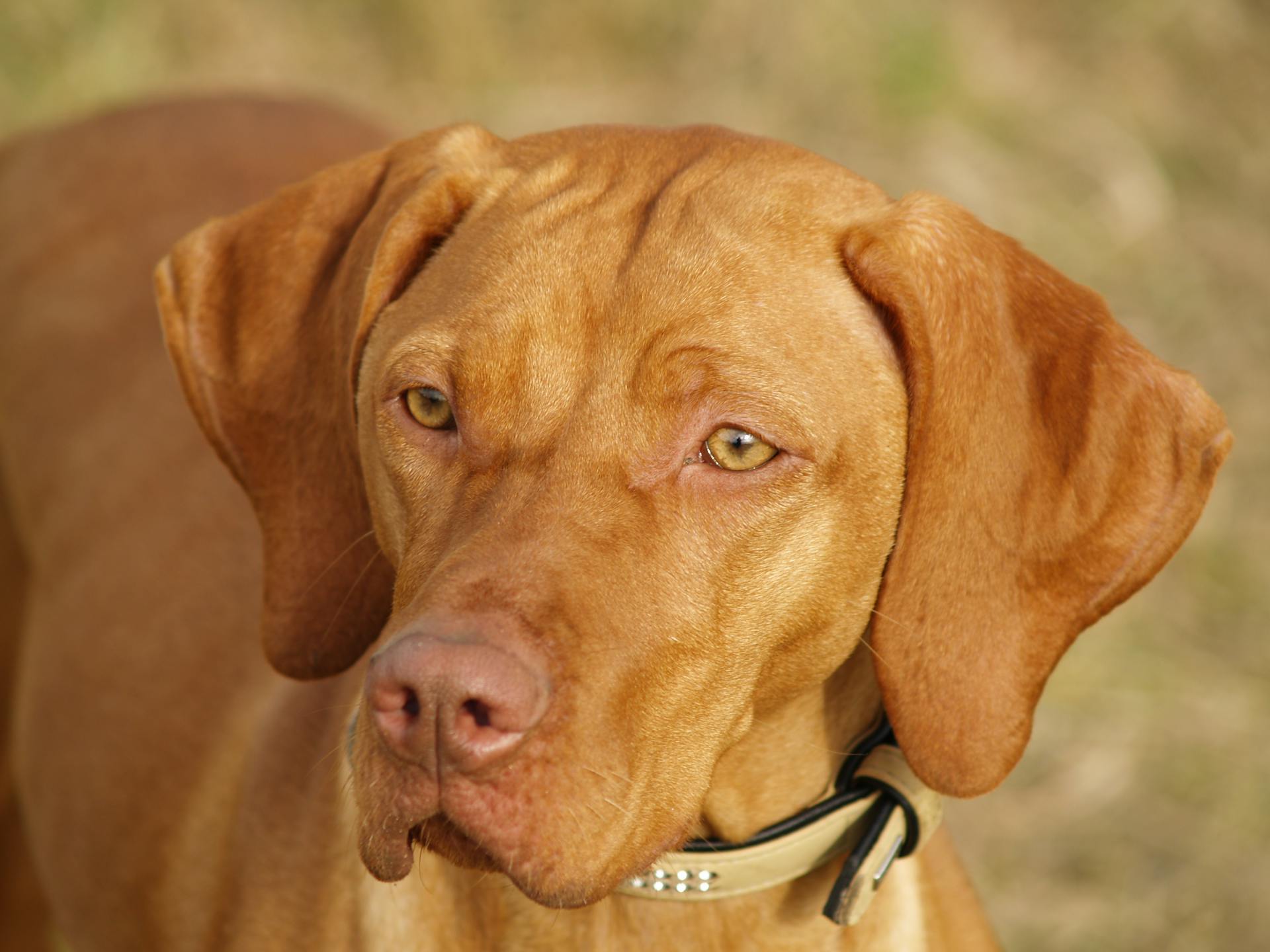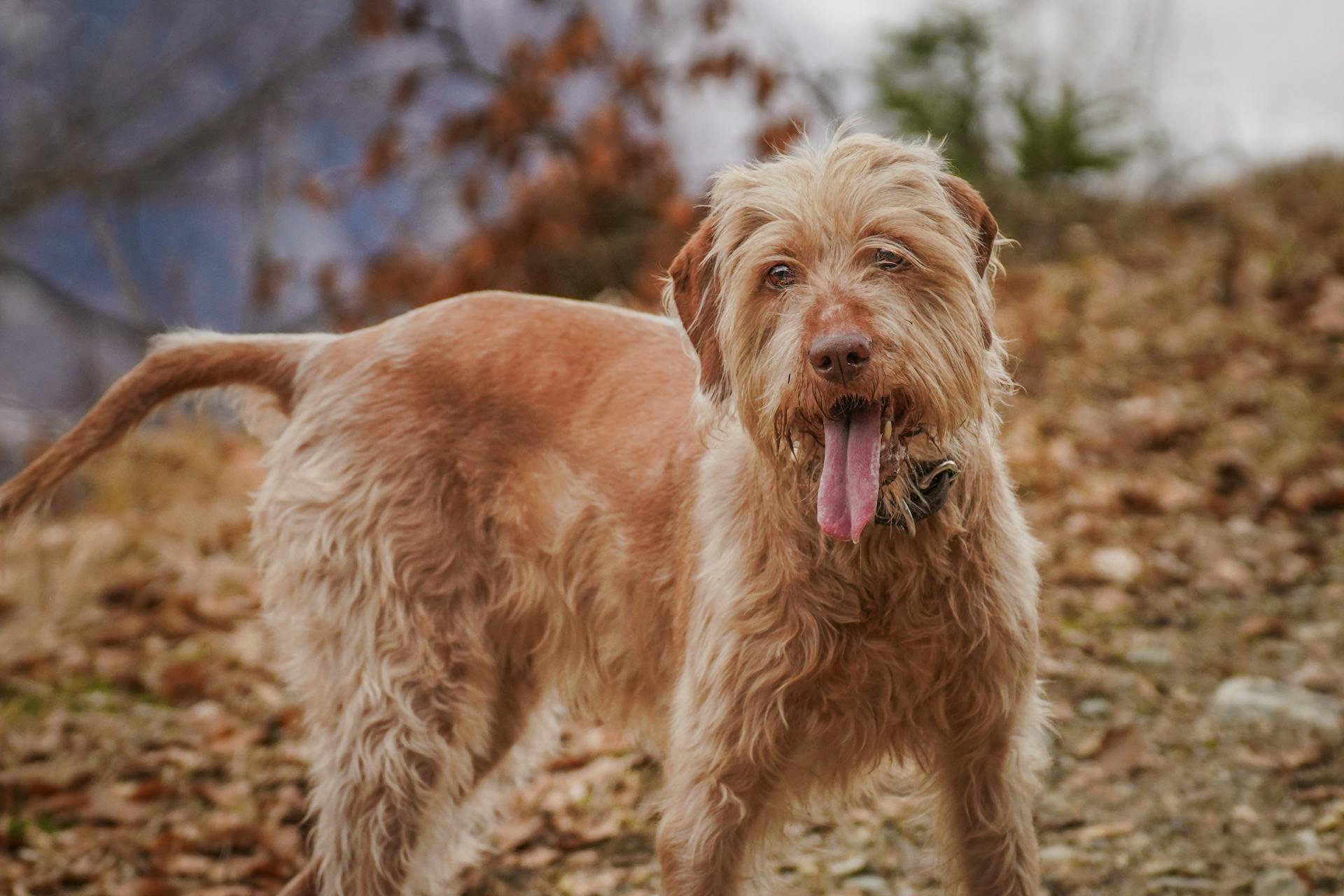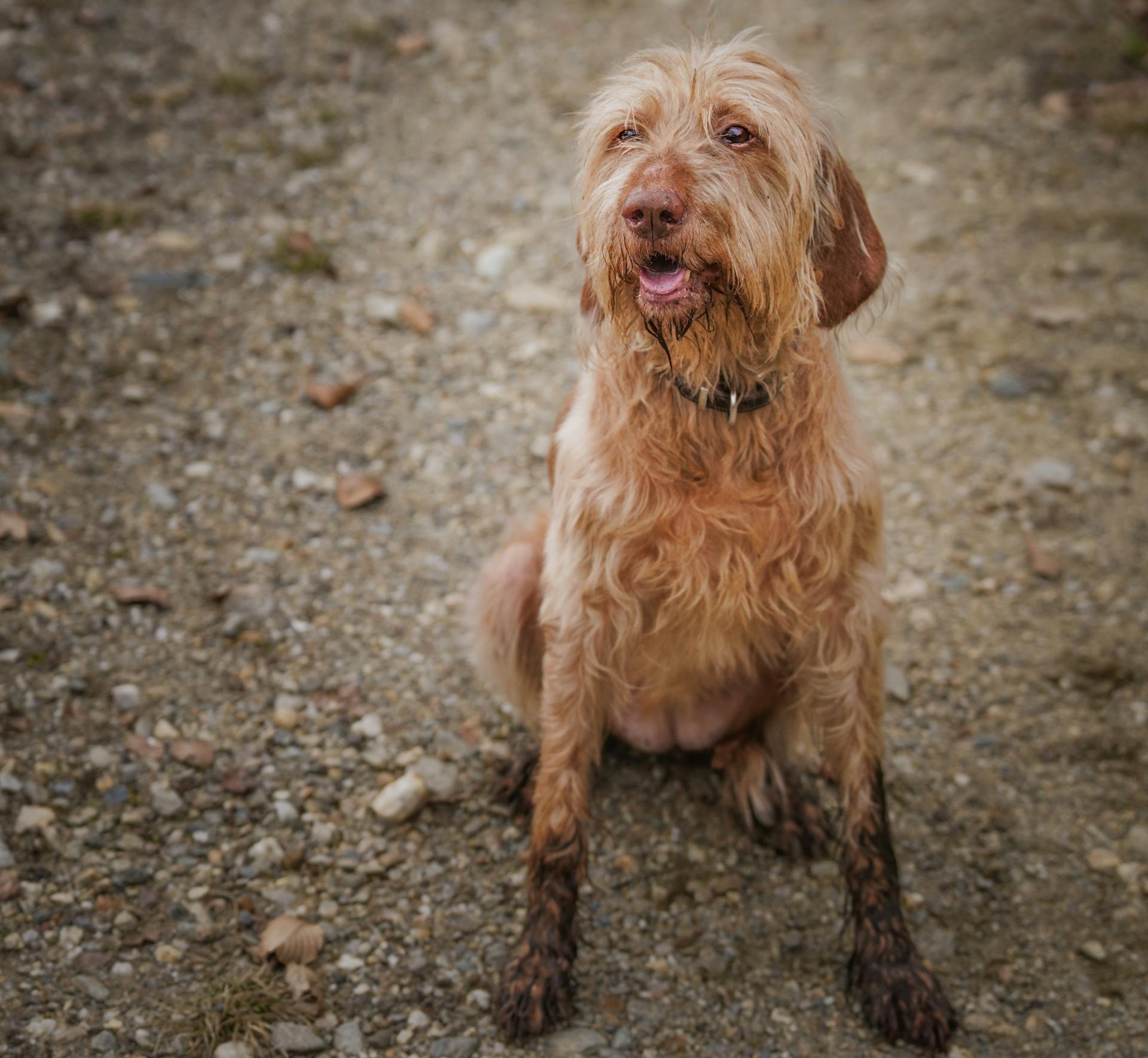The Vizsla and German Shorthaired Pointer are two popular breeds that share some similarities, but also have some key differences. Both breeds are energetic and love to run, making them great companions for active families.
One of the main differences between the two breeds is their origins. The Vizsla originated in Hungary, where it was bred to hunt game birds and small mammals, while the German Shorthaired Pointer originated in Germany, where it was bred to hunt a variety of game.
Despite their differences, both breeds are highly intelligent and trainable. They thrive on mental and physical stimulation, making them well-suited for families who enjoy outdoor activities.
On a similar theme: Game Bred American Pit Bull Terrier
[Character]
Both Vizslas and German Shorthaired Pointers are energetic breeds that require regular exercise to keep them happy and healthy.
Vizslas are known for their high energy levels and need to be kept busy with activities such as running, playing fetch, and going on long walks. They are also highly intelligent and love to please their owners, making them relatively easy to train.
German Shorthaired Pointers have a similar energy level to Vizslas and require regular exercise to keep them physically and mentally stimulated. They excel in activities such as agility, obedience, and hunting.
Both breeds are also highly social and thrive on human companionship. They make excellent family pets and are generally friendly with children and other pets.
However, it's worth noting that Vizslas can be prone to separation anxiety if left alone for extended periods of time. German Shorthaired Pointers, on the other hand, are generally more independent and can entertain themselves for longer periods of time.
Here's a comparison of the two breeds' physical characteristics and temperaments:
As you can see, both breeds share some similarities, but also have some key differences. Ultimately, the choice between a Vizsla and a German Shorthaired Pointer will depend on your individual lifestyle and preferences.
Training and Intelligence
Vizslas and German Shorthaired Pointers are both highly intelligent breeds that thrive on training and mental stimulation. They are easy to train due to their eagerness to please and quick learning abilities.
Both breeds respond well to positive reinforcement training methods, such as rewards and praise. Consistency is crucial when training these breeds, as they can become stubborn if they sense inconsistency.
Vizslas are known for their exceptional trainability and intelligence, making them an excellent choice for owners seeking a dog that is easy to train and quick to learn. They have a high level of intelligence and possess strong problem-solving abilities.
Here are some key similarities and differences between the two breeds:
Both breeds require mental stimulation and regular training sessions to prevent boredom and keep them engaged. They are highly trainable and can excel in various types of training, including obedience, agility, and hunting.
Overall, Vizslas and German Shorthaired Pointers are both excellent choices for active owners who are willing to provide the necessary training and attention.
Health and Care
Both Vizslas and German Shorthaired Pointers are generally healthy breeds, but they can be prone to certain health issues.
Vizslas are susceptible to hip dysplasia, a common disorder in large breeds that can lead to pain and mobility issues. They may also experience seizures, hypothyroidism, and progressive retinal atrophy.
German Shorthaired Pointers are known to be susceptible to hip dysplasia, certain types of cancer, and heart diseases. Regular exercise, a balanced diet, and routine vet visits can help ensure a longer and healthier lifespan for both breeds.
Here's a comparison of common health issues in Vizslas and German Shorthaired Pointers:
Both breeds require regular veterinary check-ups to monitor for these potential health issues and address any concerns early on.
Health and Lifespan
Vizslas are generally a healthy breed, but like all breeds, they can be prone to certain health issues. Hip dysplasia is a common disorder in large breeds, and Vizslas may also suffer from seizures, hypothyroidism, and progressive retinal atrophy.
Regular veterinary visits are crucial to monitor your Vizsla's health. The Vizsla should have a complete physical check-up at least once per year.

Providing a nutritious diet and regular exercise can help ensure a longer and healthier lifespan for your Vizsla. The average lifespan of Vizslas is around 10 to 14 years.
Here are some common health issues that Vizslas may experience:
- Hip dysplasia
- Progressive retinal atrophy (PRA)
- Gastric dilatation volvulus (GDV), also known as bloat
- Ear infections
- Allergies
By being aware of these potential health issues, you can take steps to prevent or manage them, and ensure your Vizsla lives a happy and healthy life. Regular check-ups and a healthy lifestyle can contribute to a long and thriving Vizsla.
Prone to Anxiety?
If you're considering bringing a German Shorthaired Pointer or Vizsla into your family, it's essential to understand that both breeds can be prone to separation anxiety. This means they may struggle with being left alone for extended periods of time.
To prevent separation anxiety, it's crucial to provide these breeds with a consistent routine, plenty of exercise, and mental enrichment. This can include activities like obedience training, agility training, and scent work.

German Shorthaired Pointers thrive on human companionship and may not do well with long periods of alone time. They need to be around their family members to feel happy and secure.
Vizslas, on the other hand, are highly intelligent and need to be kept busy with mental stimulation and exercise. If they don't receive enough physical and mental activity, they may develop destructive behaviors.
By providing your German Shorthaired Pointer or Vizsla with a stable routine and plenty of stimulation, you can help prevent separation anxiety and create a happy and healthy home for your furry friend.
Additional reading: How Much Exercise Do Labrador Retrievers Need
Suitability and Lifestyle
If you're considering bringing a Vizsla or German Shorthaired Pointer into your life, it's essential to think about your lifestyle and whether it's a good fit for one of these high-energy breeds.
Vizslas are great for extremely active single people or families with outdoor space, but they do require someone to be home most of the time.
Both Vizslas and German Shorthaired Pointers are fantastic with kids, but Vizslas are often described as "kid-loving" and may have a slight advantage in this aspect.
If you're a first-time dog owner, both breeds can be suitable, but it's recommended to work with a reputable dog trainer or behaviorist to ensure proper training and handling techniques.
Proper socialization and training are crucial for both breeds to ensure optimal behavior and to prevent any undesirable situations.
Vizslas are slightly easier to groom and shed less, but they are needier than German Shorthaired Pointers.
Here are some key points to consider when deciding between a Vizsla and a German Shorthaired Pointer:
Ultimately, the choice between a Vizsla and a German Shorthaired Pointer should align with your preferences, lifestyle, and ability to meet the needs of the selected breed.
Physical Characteristics
Vizslas and German Shorthaired Pointers are both medium-sized dogs with lean and athletic builds. Vizslas have a short, shiny coat that comes in shades of golden rust, while Pointers have a short, dense coat that can come in various colors.
Their ears are another distinctive feature, with Vizslas having long and floppy ears, and Pointers having ears that are set high and moderately long.
Here's a comparison of the two breeds' physical characteristics:
Physical Characteristics

Vizslas are medium-sized dogs with a lean and muscular build.
Their short, shiny coat comes in shades of golden rust, which requires minimal grooming.
Pointers, on the other hand, have a strong and athletic body with a short, dense coat that can come in various colors.
These colors include liver, lemon, black, or orange, and may feature distinctive patterns or patches.
Vizslas typically weigh between 45-65 pounds, with a muscular and athletic build.
Pointers also have a medium to large build, with a sleek coat that requires regular exercise to maintain its health.
The Vizsla's short, dense coat is smooth and rust-colored, while the Pointer's coat can be liver, black, or lemon in color.
Here are the physical characteristics of Vizslas and Pointers in a comparison:
Vizslas have long, floppy ears, while Pointers often have distinctive patterns or patches on their coat.
Their expressive eyes are usually a light to dark brown, adding to their charming appearance.
Pointers' eyes are almond-shaped and dark brown, with an intelligent and alert expression.
Overall, both breeds have unique physical characteristics that make them stand out as exceptional companions.
For your interest: Dark Rhodesian Ridgeback
Bite Characteristics
When evaluating the bite characteristics of German Shorthaired Pointers, Vizslas, and Weimaraners, it's essential to consider their bite force and biting potential.
The bite force of these breeds is relatively similar, ranging from 200 to 400 PSI, which is considered ordinary.
German Shorthaired Pointers, Vizslas, and Weimaraners all have a low chance of biting someone, making them relatively safe companions.
However, their mouthiness level varies, with Weimaraners having a strong tendency to nip, chew, play-bite, or herd people, and German Shorthaired Pointers and Vizslas having a higher than average tendency to do the same.
Here's a comparison of their biting potential and mouthiness level:
Overall, while these breeds have relatively low biting potential, their mouthiness level can be a consideration for owners who want to minimize the risk of nipping or play-biting.
Grooming Needs
The German Shorthaired Pointer, Vizsla, and Weimaraner are all relatively low-maintenance breeds when it comes to grooming. They have short coats that require minimal grooming, making them perfect for busy owners.

The German Shorthaired Pointer has a dense coat that sheds moderately, while the Vizsla has a fine coat that also sheds moderately. The Weimaraner has a hard, coarse coat that sheds moderately as well.
To keep their coats in good condition, occasional brushing and bathing are sufficient for the German Shorthaired Pointer and Vizsla. The Weimaraner, however, may need to be bathed more often due to its oily coat.
Here's a quick rundown of the grooming needs for each breed:
As you can see, all three breeds require regular nail trimming, ear care, and dental care to stay healthy and happy.
Here's an interesting read: Bernese Mountain Dog Care
Recognition
The German Shorthaired Pointer, Vizsla, and Weimaraner are all recognized by various kennel clubs and organizations. The American Kennel Club recognized the German Shorthaired Pointer in 1930 as a Sporting breed, while the Vizsla was recognized in 1960 and the Weimaraner in 1943.
The Federation Cynologique Internationale, or FCI, recognizes all three breeds in the Pointing Dogs group, specifically in the Continental Pointing Dogs section.
Recommended read: American Kennel Club Lancashire Heeler

Here's a list of organizations that recognize these breeds:
- German Shorthaired Pointer: American Kennel Club, Canadian Kennel Club, Federation Cynologique Internationale, Kennel Club of Great Britain, Australian National Kennel Council, New Zealand Kennel Club, United Kennel Club
- Vizsla: American Canine Registry, American Kennel Club, America's Pet Registry, Canadian Kennel Club, Dog Registry of America Inc., Federation Cynologique Internationale, Kennel Club of Great Britain, North American Purebred Registry, Inc., American Canine Association, Inc., Australian National Kennel Council, Continental Kennel Club, National Kennel Club, New Zealand Kennel Club, United Kennel Club
- Weimaraner: American Canine Registry, American Kennel Club, America's Pet Registry, Canadian Kennel Club, Dog Registry of America Inc., Federation Cynologique Internationale, Kennel Club of Great Britain, North American Purebred Registry, Inc., American Canine Association, Inc., Australian National Kennel Council, Continental Kennel Club, National Kennel Club, New Zealand Kennel Club
These organizations ensure that these breeds are recognized and their characteristics are preserved.
Needs and Requirements
Both Vizslas and German Shorthaired Pointers require regular exercise and mental stimulation to stay happy and healthy. They thrive on activities like running, hiking, and playing fetch, and need at least 1-2 hours of vigorous exercise every day.
To meet their exercise requirements, both breeds need physical activity, mental stimulation, and outdoor exploration. Vizslas require at least an hour of vigorous exercise daily, while German Shorthaired Pointers need at least 1-2 hours of vigorous exercise daily.
Here's a comparison of their exercise needs:
Regular exercise and mental stimulation are crucial for both breeds to prevent behavioral issues and keep them happy and healthy.
Requirements
Both German Shorthaired Pointers and Vizslas are highly active breeds that require regular exercise to keep them happy and healthy. They need at least 1-2 hours of vigorous exercise every day to burn off energy and maintain a healthy weight.

Vizslas require at least an hour of vigorous exercise daily, and they thrive on activities like running, hiking, or playing fetch. They also benefit from mental exercises like obedience training, puzzle toys, or interactive games.
Pointers are intelligent dogs that are generally easy to train, but they do require firm leadership and consistency during training to prevent them from becoming stubborn. Consistent and patient training methods are recommended to bring out the best in a Vizsla.
To meet their exercise requirements, both breeds need access to outdoor space where they can run and explore. A secure outdoor space is essential for Pointers, while Vizslas thrive in homes with large yards where they can freely run and explore.
Here are the specific exercise requirements for both breeds:
Regular exercise is crucial for both breeds to prevent any behavioral issues that may arise due to pent-up energy.
Reproducibility
When breeding dogs, it's essential to consider their reproductive needs.

The gestation length for German Shorthaired Pointers, Vizslas, and Weimaraners is 60-64 days.
Breeding frequency is crucial for the health of these breeds. More frequent breeding is not healthy, so it's recommended to breed them once a year.
Here's a comparison of the litter sizes for these breeds:
Interacting with Strangers
Both breeds are moderately friendly towards strangers and generally have an easygoing temperament.
They make great family pets, but it's essential to socialize them well, especially as puppies, to ensure they're comfortable around new people.
Both German Shorthaired Pointers and Vizslas are relatively easy-going towards strangers, making them a great choice for families who want a low-maintenance companion.
Choosing Between
Choosing Between a Vizsla and a German Shorthaired Pointer requires careful consideration of various factors. If you're trying to make a decision, here are some key points to help you in your decision-making process:
Vizslas are known for being affectionate and sensitive, whereas German Shorthaired Pointers tend to be more independent and reserved. This difference in temperament can greatly impact your relationship with your dog.
Vizslas are highly energetic and need plenty of exercise and mental stimulation, while German Shorthaired Pointers are also active, but their energy levels may be slightly lower.
Both breeds have short coats that don't require much maintenance, but German Shorthaired Pointers have a slightly longer coat that needs regular brushing to keep them looking their best.
In terms of trainability, both Vizslas and German Shorthaired Pointers are intelligent breeds, but Vizslas can sometimes be more stubborn, so they require consistent and patient training.
To ensure the chosen breed fits your needs, consider your lifestyle, living arrangements, and the time you can commit to them. This includes factors like exercise, grooming, and training requirements.
Here's a quick comparison of the two breeds:
Ultimately, the choice between a Vizsla and a German Shorthaired Pointer should align with your preferences, lifestyle, and ability to meet the needs of the selected breed.
Frequently Asked Questions
Are Vizslas a type of pointer?
Yes, Vizslas are versatile hunting dogs that can work as pointers, but they also excel as retrievers. Their ancestors were bred to be swift and cautious hunters on the open plains of Hungary.
Is a Vizsla a pointer?
Yes, the Vizsla is a pointer dog, specifically a medium-sized breed in the Sporting group. Known for their agility, they excel at retrieving game in smaller spaces.
Sources
- https://www.hepper.com/vizsla-vs-german-shorthaired-pointer/
- https://be.chewy.com/dog-breeds/compare/vizsla-vs-german-shorthaired-pointer/
- https://blog.tryfi.com/comparing-vizslas-and-pointers-which-hunting-breed-is-right-for-you/
- https://dogell.com/compare-dog-breeds/german-shorthaired-pointer-vs-vizsla-vs-weimaraner
- https://blog.tryfi.com/gsp-vs-vizsla-comparison/
Featured Images: pexels.com


